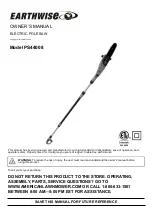
PTSS 1200 C2
GB
│
IE
│
11
■
Mitre angles up to 45°
♦
Apply the guide rail with the foam rubber
elements onto the workpiece.
♦
Place the appliance with the groove onto
the guide rail .
♦
Adjust the cutting angle as described.
♦
Hold the machine with both hands firmly on
the handles and .
♦
Switch on the appliance as described in
"Switching on and off". Place the appliance
with the front part of the base plate on the
workpiece.
♦
Swivel the motor down and saw forwards with
moderate pressure – never backwards.
Plunge cutting using the guide rail
♦
Apply the guide rail with the foam rubber
elements onto the workpiece.
♦
Place the appliance with the groove onto
the guide rail .
♦
Adjust the desired cutting depth as described
above.
♦
Place the rear edge (as far as possible) against
a stop.
♦
Switch on the appliance as described in
"Switching on and off".
♦
Hold the machine with both hands firmly on
the handles and and pivot it.
NOTE
►
The cutting width marking on the side
of the blade guard shows the front and rear
cutting point of a 165 mm saw blade at
maximum cutting depth. This applies both
for plunge cuts using the guide rail and
plunge cuts without using the guide rail .
Further applications are not permitted.
Cleaning and maintenance
WARNING! RISK OF INJURY! Switch
the appliance off and remove the
power plug before starting any work
on the appliance.
■
The appliance must always be kept clean, dry
and free from oil or grease.
■
Use a soft, dry cloth to clean the housing.
NOTE
►
Replacement parts not listed (such as carbon
brushes, switch) can be ordered via our
service hotline.
Disposal
The packaging is made from environ-
mentally friendly material and can be
disposed of at your local recycling
plant.
Do not dispose of power tools
in your normal domestic waste!
European Directive 2012/19/EU
requires that worn-out power tools are
collected separately and recycled in an environ-
mentally compatible manner.
Dispose of the packaging in an
environmentally friendly manner.
Note the labelling on the packaging
and separate the packaging material
components for disposal if necessary. The pack-
aging material is labelled with abbreviations (a)
and numbers (b) with the following meanings:
1–7: plastics, 20–22: paper and cardboard,
80–98: composites.
Your local community or municipal
authorities can provide information
on how to dispose of the worn-out
product.
The product is recyclable, subject to
extended producer responsibility and
is collected separately.
Summary of Contents for PTSS 1200 C2
Page 3: ...A B C 8a 9a 14a 14b X...















































